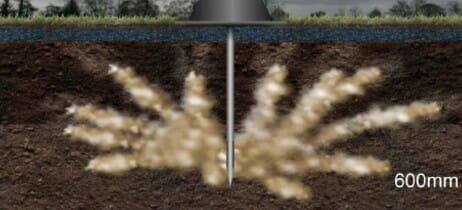The Terravent was originally developed as a joint project by the RHS, Kew and Pinnacle products as a way of recreating the beneficial ground effect of the 87 Hurricane without the downsides.
The terravent works by driving a 22mm probe, with the hammer built into the terravent unit, into the soil and releasing a pressurised charge of nitrogen gas, up to 50bar or 725psi, or compressed air into the soil, fracturing the soil compaction both vertically and horizontally, creating fissures for air, moisture, and roots to freely move throughout the soil profile.

This can be done at any depth up to 700mm, or up to 1500mm in special circumstances, below the ground with a 2-metre spacing, although in heavily compacted ground we do go tighter.
Immediately after fracturing, the terravent offers the option to “inject” beneficial nutrients, fungi, and bacteria via its liquid amendment chamber or solid materials such as activated biochar, milled seaweed and zeolite mix depending on the machine used. This will boost the soil food web, adding much-needed bio-available nutrients to the improved soil structure as well as naturally increasing the symbiotic bacterial and fungal microbiome of the soil.
Post injection the probe holes can be back-filled with a mix of activated biochar, worm casts and, when conditions allow, live worms can also be introduced to continue the process long after we’ve left.
If the area to be de-compacted is beneath existing hard standing it is possible to drill through the wearing course and sub-base with our Battery SDS drill to allow access for the terravent probe.
Depending on the system used it is either contained within its own purpose-built trailer or as a stand alone unit linked to a Stage V low emission compressor with the terravent heads on up to 45m of hose meaning any vehicles, either the tow vehicle or our low ground pressure compact tractor for sensitive sites, and the trailer or compressor are kept outside of the area to be de-compacted. In addition, the terravent is the only machine that doesn’t rely on a powered carrier riding over the area to be de-compacted, carries enough gas and nutrients for more than a day’s work and is the only real alternative to the airspade for tree rooting area aeration.